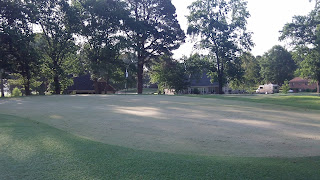The main reason to vertical mow is thatch reduction. Thatch is a layer of dead grass and plant material between the canopy of the turf and the surface to the soil. Excess thatch causes the greens to become soft and spongy which will cause the ball to roll slow and bounce. Thatch can also cause dry spots because water can not infiltrate the turf and soak into the soil. The worse problem with thatch is it can harbor pathogens which can cause disease if conditions are right.
Today we did the work that is usually scheduled for Monday. First thing this morning we started vertical mowing the greens, otherwise known as verticutting. The direction of cut was 10-4 if looking at the green. We went up and down the same pass, effectively double cutting the green, but all the passes are at the same angle.
 Our process is to vertical mow the greens and then add a thin layer of sand called topdressing.
Our process is to vertical mow the greens and then add a thin layer of sand called topdressing. After the sand is applied we sweep or brush it into the canopy. The sand also helps to reduce thatch. Another bonus of the sand is the fact that it smooths and firms the surface. A smooth and firm putting surface is the objective.
After the sand is applied we sweep or brush it into the canopy. The sand also helps to reduce thatch. Another bonus of the sand is the fact that it smooths and firms the surface. A smooth and firm putting surface is the objective.  The sand is noticeable for a few days, but does not affect the ball roll in any negative way.
The sand is noticeable for a few days, but does not affect the ball roll in any negative way.After a few days the greens are completely healed and ready to be done again.


No comments:
Post a Comment